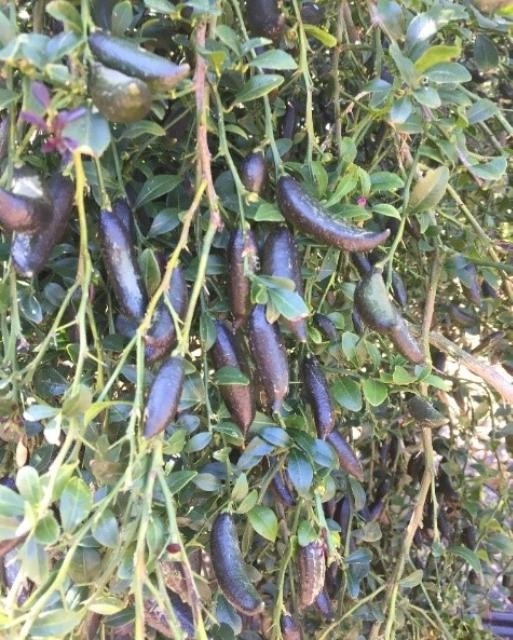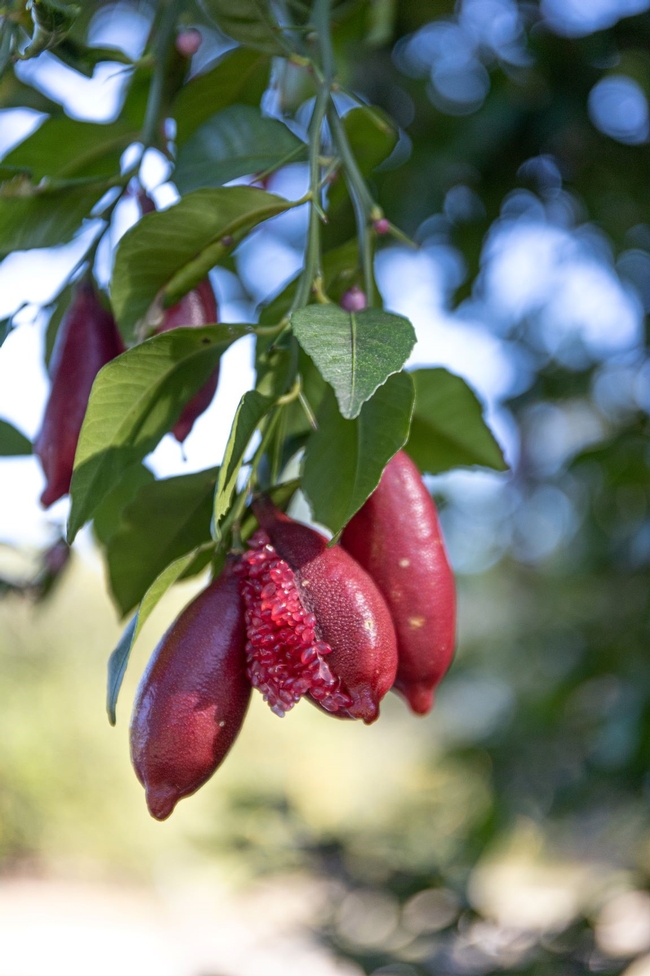Trent Blare (tblare@ufl.edu), Assistant Professor in Food Resource Economics, University of Florida.
There has been growing hype around finger limes from citrus growers, the retail sector, and their customers. Growers are particularly interested in this market as disease pressure such as citrus greening and international competition have made other citrus and fruit markets less appealing. However, many are concerned that finger limes are just a fad and the markets will eventually crash as consumers move on to the next cool food trend. Our research at the University of Florida is examining these markets to determine the potential for growers in Florida and throughout the U.S. to take advantage of the emerging finger lime market.
Finger limes are known as the “citrus caviar,” because of their unique compressed, round juice vesicles that are distinct from other citrus crops' delicate, tear shaped fruit sacs. This feature combined with its bright colors and tangy flavor make finger limes a great garnish used in high end restaurants and as a perfect accent to a cocktail. As more and more chefs, bartenders, and suppliers in the hospitality industry become familiar with the fruit, they are falling in love with them and demand for finger limes is rapidly growing.
Figure 1. Finger lime plant (top – courtesy of Jeff Wasielewski, UF/IFAS) and fruit (bottom – courtesy of Cristina Carriz UF/IFAS).
Many growers and suppliers of finger limes are hopeful that the demand for this fruit will expand beyond the hospitality sector to mass markets, as consumers across the U.S. and around the world become more familiar with the fruit. Finger limes are not only resistant to greening that plagues orange and other citrus production but also have traditionally been grown using few agrochemical inputs (Singh et al. 2017). So, there are expectations that organic markets could provide an additional premium for this fruit. Some research has also pointed out the high prevalence of antioxidants in the fruit, providing finger lime growers and suppliers with potential to enter health food markets (Netzel et al. 2017).
This fruit, which is native to Australia, has only in the last several years become commercially available to growers across the US, after first having been cultivated in California in late 1960s (Singh et al. 2017). In fact, nearly all of the current production in the U.S. is in central and southern California and the big island of Hawaii. There are only about 15,000 trees, which are owned by less than a dozen growers (Karp 2009). So, there is room to expand production especially by Florida growers, who supply East Coast markets. Prices are quite elevated for the fruit; for instance, during the spring of 2020 finger limes were priced at $32 for 80 grams or 8 limes on Amazon or $18 for 9 to 10 finger limes from one of the only suppliers in South Florida. Questions remain whether these prices will remain elevated as more and more growers enter the market.
Over the next two years, we at the University of Florida will be exploring the potential for finger limes in these markets and how to develop inclusive supply chains to improve the participation of all growers in them. We will hold taste testing panels and interviews with suppliers, chefs, and bartenders at trade fairs to introduce them to the product, gauge their interest in the fruit, and estimate their willingness to pay for finger limes. The analysis of this research will allow us to estimate the potential demand of the fruit and how many growers could participate in this market. Additionally, we will examine the supply chain to determine which factors need to be addressed to improve growers' access to these growing markets. Please be on the lookout for further updates as we examine the potential growers to tap into growing finger lime markets and determine what can be done to sustain the demand for them.
Further reading:
Delort, E., & Yuan, Y. M. (2018). Finger lime/the Australian caviar—Citrus australasica. In Exotic Fruits, S. Rodrigues, E. de Oliveira Silva, & E. Sousa de Brit (eds). Academic Press, Cambridge, MA: 203-10.
Karp, D. (2009). Finger lime: The caviar of citrus. Los Angeles Times, 23. http://old.weshipproduce.com/shipping/122309lat.pdf
Netzel, M., Netzel, G., Tian, Q., Schwartz, S., & Konczak, I. (2007). Native Australian fruits—a novel source of antioxidants for food. Innovative Food Science & Emerging Technologies, 8(3), 339-346
Rennie, S. (2017). Cultivation of Australian finger lime (Citrus australasica). In Australian Native Plants: Cultivation and Uses in the Health and Food Industries, Y. Sultanbawa & F. Sultanbawa (eds). CRC Press, Boca Raton, FL: Chapter 7.
Scott, T. (2017). The caviar of citrus. California Bountiful Magazine. https://www.californiabountiful.com/features/article.aspx?arID=1967
Singh, A., Evans, E., Wasielewski, J., Dutt, M. & Grosser. J. (2017). Finger lime: An alternative crop with great potential in South Florida. EDIS 2017 https://edis.ifas.ufl.edu/pdffiles/FE/FE103300.pdf

